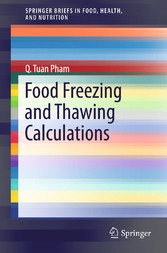Suchen und Finden
Preface
5
Contents
7
Nomenclature
10
Chapter-1
15
Introduction to the Freezing Process
15
Chapter-2
19
Heat Transfer Coefficient and Physical Properties
19
2.1 Introduction
19
2.2 Heat Transfer Coefficient
19
2.3 Density
20
2.4 Calorimetric Properties
22
2.4.1 Freezing Point
22
2.4.2 Bound Water
24
2.4.3 Frozen Fraction
25
2.4.4 Enthalpy
27
2.4.5 Sensible Specific Heat
29
2.4.6 Apparent Specific Heat
30
2.4.7 Calorimetric Properties at High Pressure
31
2.4.7.1 Freezing Point at High Pressure
31
2.4.7.2 Enthalpy–Temperature Curve
32
2.5 Thermal Conductivity
32
2.6 Thermal Properties of Tylose Gel
36
2.7 Summary and Recommendations
37
CAUTION
38
Chapter-3
39
Analytical Solutions
39
3.1 The Heat Conduction Equation
39
3.2 Analytical Solutions for Freezing Time
40
3.2.1 Solution for Zero Internal Resistance
41
3.2.2 Solution for Zero Sensible Heat: Plank’s Equation
41
3.2.3 The Biot Number
43
3.2.4 Shape Factors for Zero Sensible Heat in Two and Three Dimensions
44
3.2.5 Exact Analytical Solutions for Freezing with Sensible Heat
46
3.2.6 Perturbation Solutions for Freezing with Sensible Heat
49
3.3 Summary and Recommendations
49
CAUTION
50
Chapter-4
51
Approximate and Empirical Methods
51
4.1 Introduction
51
4.2 Freezing Time of 1-D Shapes
51
4.2.1 Cleland & Earle’s Empirical Method
51
4.2.2 Mascheroni & Calvelo’s Approximate Method
52
4.2.3 Pham’s Method 1 (1984)
53
4.2.4 Pham’s Method 2 (1986)
54
4.2.5 Salvadori & Mascheroni’s Method
55
4.2.6 Improved Shape Factors for Basic Geometries
56
4.2.7 Comparison of Approximate and Empirical Freezing Time Prediction Methods in 1-D
57
4.2.8 Freezing Time Prediction for Extended Parameter Range
59
4.3 Freezing Time of Multidimensional Shapes
62
4.3.1 Equivalent Shape Approach
62
4.3.2 EHTD Shape Factor Approach
62
4.3.2.1 Infinite Rectangular Rods, Bricks, Finite Cylinders
62
4.3.2.2 Elliptical Cylinders (2-D)
63
4.3.2.3 Three-Dimensional Ellipsoids
64
4.3.2.4 Irregular Shapes
65
4.3.3 Mean Conducting Path (MCP) Approach
66
4.3.3.1 MCP for Rectangular Rods and Bricks
67
4.3.3.2 MCP for Ellipses and Ellipsoids
67
4.3.4 Arroyo & Mascheroni’s Method
68
4.3.5 Comparison of Shape Factor and Mean Conducting Path Approaches
68
4.4 Thawing Time Prediction
69
4.4.1 Cleland et al.’s method
70
4.4.2 Salvadori and Masheroni’s Method
70
4.4.3 Thawing Time Prediction for Multi-Dimensional Shapes
71
4.5 Freezing Heat Load
71
4.5.1 Total and Average Heat Load
71
4.5.2 Heat Load During the Phase Change-Subcooling Period
73
4.5.3 Dynamic Heat Load During the Precooling Period
75
4.5.3.1 Analytical Solutions
75
4.5.3.2 Lovatt et al.’s Method
75
4.5.3.3 Pham’s Method
76
4.5.4 Summary of Method
77
4.6 Summary and Recommendations
77
CAUTION
78
Chapter-5
79
Numerical Methods
79
5.1 Introduction
79
5.2 Discretization of the Space Domain
80
5.2.1 Finite Difference Method (FDM)
81
5.2.2 Finite Volume Method (FVM)
84
5.2.3 Finite Element Method (FEM)
85
5.2.4 Discretization of the Space Domain in 2-D and 3-D
89
5.3 Time-Stepping
90
5.3.1 Two-Level Stepping Schemes
90
5.3.2 Lee’s Three-Level Scheme
92
5.3.3 Use of Generic ODE Solvers
93
5.3.4 Time Stepping in Structured Grid FDM and FVM
93
5.4 Dealing with Changes in Physical Properties
95
5.4.1 Latent Heat of Freezing
95
5.4.1.1 Classification of Methods
95
5.4.1.2 Fictitious Heat Source Methods
96
5.4.1.3 Apparent Specific Heat Methods
97
5.4.1.4 Enthalpy Methods
98
5.4.1.5 Pham’s Temperature Correction Method (Quasi-enthalpy Method)
100
5.4.2 Variable Thermal Conductivity
102
5.4.3 Variable Density due to Thermal Expansion
104
5.5 Convergence and Accuracy of Numerical Methods
105
5.6 Summary and Recommendations
106
CAUTION
107
Chapter-6
108
Modelling Coupled Phenomena
108
6.1 Introduction
108
6.2 Combined Heat and Mass Transfer
108
6.2.1 Mass Transfer During the Freezing of Dense Foods
109
6.2.2 Mass Transfer During Air Freezing of Porous Foods
111
6.2.3 Mass Transfer During Immersion Freezing
117
6.2.4 Mass Transfer Between Intra- and Extracellular Spaces
117
6.3 Supercooling and Nucleation Effects
118
6.3.1 Instantaneous Nucleation Followed by Dendritic Crystal Growth
118
6.3.2 Gradual Nucleation in an Emulsion
119
6.3.3 Gradual Nucleation in Cellular Tissues
120
6.4 Microscale Modelling of Crystal Growth
123
6.4.1 Enthalpy Method
124
6.4.2 Cellular Automata
125
6.4.3 Front Tracking or Sharp Interface Methods
125
6.4.4 Level Set Method
125
6.4.5 Phase Field Method
126
6.5 High Pressure Freezing and Thawing
129
6.6 Freeze Concentration
131
6.6.1 General Principles
131
6.6.2 Suspension Freeze Concentration Model
133
6.6.3 Layer Freeze Concentration Models
133
6.7 Freezing of Liquid Foods
135
6.7.1 CFD Model of Liquid Food Freezing
135
6.7.2 Freezing of a Well-Stirred Liquid
137
6.8 Microwave and Radio Frequency Thawing
138
6.8.1 General Principles
138
6.8.1.1 Lambert’s Law
138
6.8.1.2 Maxwell’s Equations
139
6.8.2 Analytical Solutions
140
6.8.3 Numerical Solutions
140
6.9 Thermomechanical Effects During Freezing
141
Chapter-7
145
Conclusions
145
Erratum
148
References
149
Index
161
Alle Preise verstehen sich inklusive der gesetzlichen MwSt.













